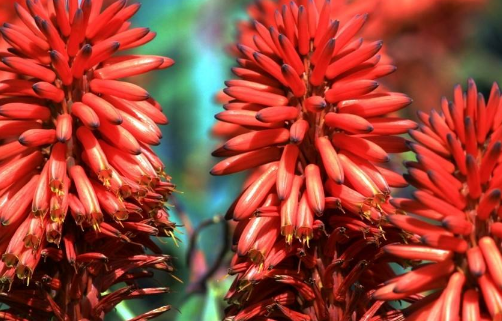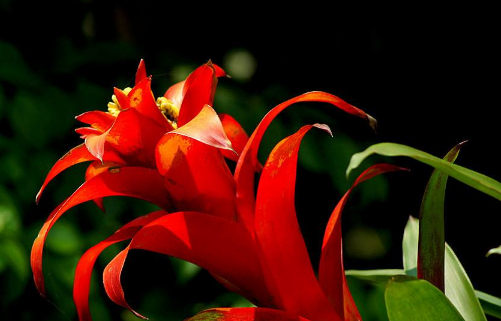Maintenance and management of torch flowering period
In fact, the flowering of torch flower is also related to its whole growth. First of all, when cultivating torch flowers, we need to meet the needs of water and fertilizer, apply sufficient base fertilizer and topdressing in time during the growth period, and water the right amount to keep the basin soil moist. If the torch flower meets the nutrient demand, it will grow well and blossom normally.

When the scape of the torch flower begins to appear, one or two potassium dihydrogen phosphate can be applied for extra-root topdressing, usually at an interval of 7 Murray for 10 days. Or topdressing with calcium superphosphate. The use of these phosphorus and potassium fertilizers can make the torch flower blossom more gorgeous, and the number of flowers will be relatively large.
Before the torch flower blossoms, it is necessary to increase the amount of water to meet the needs of flowering. And after the flowers have withered, stop watering.
Note that during the flowering period of the torch flower, it may be disturbed by some diseases and insect pests, such as the bite of beetles and other pests, which need to be controlled by spraying chemicals in time.
After reading these, are you very curious about the flowers of the torch flower? Then go and buy a basin that is easy to feed. As soon as the florescence comes, you can see the flowers of the torch flower.
How to maintain the flowering period of torch
When will the torch blossom
Generally speaking, the torch flower blossoms from late May to mid-June, but if the seed is sown in the previous year and transplanted in April-June of the following year, it can blossom from September to October.
When the torch blossoms, there are hundreds of small flowers growing on the whole inflorescence, which looks like a big torch.
Maintenance and management of torch flowering period
In fact, the flowering of torch flower is also related to its whole growth. First of all, when raising torch flowers,
Need to meet the needs of water and fertilizer, apply sufficient base fertilizer and topdressing in time during the growth period, watering should also be appropriate to keep the basin soil moist. If the torch flower meets the nutrient demand, it will grow well and blossom normally.
When the scape of the torch flower begins to appear, one or two potassium dihydrogen phosphate can be applied for extra-root topdressing, usually at an interval of 7 Murray for 10 days. Or topdressing with calcium superphosphate. The use of these phosphorus and potassium fertilizers can make the torch flower blossom more gorgeous, and the number of flowers will be relatively large.
Before the torch flower blossoms, it is necessary to increase the amount of water to meet the needs of flowering. And after the flowers have withered, stop watering.
Note that during the flowering period of the torch flower, it may be disturbed by some diseases and insect pests, such as the bite of beetles and other pests, which need to be controlled by spraying chemicals in time.
How to maintain the flowering period of torch? the maintenance method of torch flower in the four seasons
Flower bonsai network guide, today the flower bonsai network editor for you to share is about the gardenia yellow bud does not blossom how to do, let's take a look.
Torch flower, alias: red fire stick, torch lotus, Latin name: Kniphofia uvaria, Liliaceae, torch lotus perennial herbs. Like warmth, it is suitable to grow in loose and fertile sandy soil. Can be planted in the lawn or planted next to rockery, used as a backdrop. Often appear in some poems, metaphor Sheng warm scene is big!
The flowering of torch flowers is quite conspicuous, but it is necessary to maintain the florescence reasonably. So, when is the flowering time of the torch flower, and how should it be maintained?
When will the torch blossom
Generally speaking, the torch flower blossoms from late May to mid-June, but if the seed is sown in the previous year and transplanted in April-June of the following year, it can blossom from September to October.
When the torch blossoms, there are hundreds of small flowers growing on the whole inflorescence, which looks like a big torch.
Maintenance and management of torch flowering period
In fact, the flowering of torch flower is also related to its whole growth. First of all, when raising torch flowers,
Need to meet the needs of water and fertilizer, apply sufficient base fertilizer and topdressing in time during the growth period, watering should also be appropriate to keep the basin soil moist. If the torch flower meets the nutrient demand, it will grow well and blossom normally.
When the scape of the torch flower begins to appear, one or two potassium dihydrogen phosphate can be applied for extra-root topdressing, usually at an interval of 7 Murray for 10 days. Or topdressing with calcium superphosphate. The use of these phosphorus and potassium fertilizers can make the torch flower blossom more gorgeous, and the number of flowers will be relatively large.
Before the torch flower blossoms, it is necessary to increase the amount of water to meet the needs of flowering. And after the flowers have withered, stop watering.
Note that during the flowering period of the torch flower, it may be disturbed by some diseases and insect pests, such as the bite of beetles and other pests, which need to be controlled by spraying chemicals in time.
Maintenance method of torch flower in four seasons
Torch flowers like a warm and sunny environment and are required to stay moist. So when raising torch flowers, how should they be maintained all the year round?
Key points of summer conservation of torch flowers
In the summer, torch flowers need to maintain an adequate water supply, and need to be fertilized in time. When the water and fertilizer conditions are satisfied, the torch flower will grow more rapidly. at this time, give the torch flower enough light and keep the temperature between 25 ℃ and 28 ℃, and it will blossom in a few months. Note that topdressing should be carried out in time when the flower stem begins to grow.
Key points of autumn maintenance of torch flower
In autumn, torch flowers can be propagated by individual plants. The time for ramet is generally from late September to early October. When ramet is carried out, we need to use base fertilizer first to supplement the nutrients of the plant.
Note that after the cultivation of the torch for a period of time, the root system of the plant will reduce its ability to absorb nutrients, so it needs to be ramified, usually once every 2-3 years.
Key points of winter maintenance of torch flower
Torch flower overwintering, the first thing is to consider the accumulation of nutrients. Generally speaking, if there is more nutrient accumulation, it will be easier to survive the winter. Therefore, after the torch flower blossoms, it is necessary to cut off the residual flowers in time, so that the plants will not bear fruit and reduce the consumption of nutrients.
The second is to water thoroughly, which can meet the needs of torch flowers overwintering.
It is best to cover the cold to make it safe to survive the winter, usually hay or fallen leaves. Be careful to remove the cold shield in early spring, but not too early, so as not to encounter the late spring cold and freeze the plant.
Training methods and management
Torch flower can be cultivated in open field or potted in many rows. The planting site should choose clayey loam with high and dry terrain, leeward and sunny place and rich in humus. Before planting, apply more mature organic fertilizer, increase phosphorus and potassium fertilizer, and then dig deep into the soil. The height of the seedling was fixed around 10cm, and the row spacing was 30cm × 40cm. After planting, the seedlings were watered twice, and then ploughed, loosened soil and squatted seedlings to promote the development of new roots.
If sufficient water supply and topdressing are needed in summer, it will grow rapidly, and under the condition of 25-28 ℃ and sufficient sunshine, it can heading and blossom in about 5 months. When the flower stem appears, the extra-root topdressing of 2 Murray potassium dihydrogen phosphate should be carried out. Each time the interval is 7-10 days, the concentration is 0.1%, or 1%-2% calcium superphosphate is used as soil topdressing, which can increase the stiffness of the flower stem and prevent bending. More basal fertilizer should be applied before dividing and planting in autumn to supplement the lack of nutrition in the plant.
The overwintering ability of torch flower is closely related to the accumulation of nutrients in its body. After flowering, the residual flower branches should be cut off as soon as possible so as not to make it fruiting so as not to consume nutrients. In dry areas in winter and spring, water should be poured through before freezing, and plants should be covered with hay or fallen leaves to prevent drying and freezing death. It is late to remove the cold cover in early spring, so pay attention to the attack of cold in late spring to prevent plant damage.
Torch flower is a shallow root flower with slightly fleshy root system, less root hair, dense and clustered root system, less root hair and lower absorptive capacity, so it must be replanted every 2-3 years. To promote the growth of new roots.
Water twice when transplanting seedlings, squatting seedlings under ploughing and loosening soil, promoting new roots, at 25-28.
When planted on the ground, it is necessary to apply sufficient base fertilizer. Watering in time after planting, fertilizing once a month during the peak growth period in spring and summer. Water thoroughly before flowering to keep the soil moist. Watering can be reduced after flowering, and the tips of old leaves turn red or wither after the first frost, but remain evergreen. Cover the ground with hay or fertile soil in winter to prevent frost damage.
Sowing and raising seedlings in greenhouse in January, planting in open field in April, and flowering from July to August in summer. Appropriate amount of base fertilizer should be applied before planting, and after transplanting or ramet, the seedlings should be thoroughly watered for 2 to 3 times, weeding in time and keeping the soil moist. When the scape appears, it is necessary to apply 0.1% potassium dihydrogen phosphate topdressing for 2 times, with an interval of 7 to 10 days, or with 1%-2% superphosphate topdressing once to enhance the stiffness of the scape. Increase irrigation before flowering, and stop watering after flower fade. Torch flower has strong cold tolerance, so open field cultivation should be covered with grass to keep warm in order to survive the winter safely.
Appropriate amount of base fertilizer, phosphorus and potassium fertilizer should be applied before planting. After transplanting or ramet, the seedlings should be watered for 2-3 times, cut weeds and keep the soil moist in time, and resume growth after about 2 weeks. When the scape appears, it is necessary to apply 0.1% potassium dihydrogen phosphate external topdressing 2-3 times, each time at an interval of 7-10 days, or with 1% Murray 2% superphosphate topdressing once, to enhance the stiffness of the scape and prevent bending. Increase irrigation before flowering, and stop watering after the flowers fade.
Potted plant management
Lack of light
Catharanthus roseus likes a warm, sunny environment. If potted plants are placed in shade for a long time, the leaves will turn yellow due to lack of light.
Poor ventilation of basin soil
Catharanthus roseus requires loose matrix and good ventilation, such as planting in clayey alkaline soil, resulting in poor root development due to soil consolidation, affecting the growth of aboveground parts and yellowing leaves.
Lack of fertilizer and stagnant water or excessive humidity
Potted Catharanthus roseus in the growing period, such as insufficient fertilization and too much watering or poor drainage, will cause the leaf color to turn yellow. In view of the above reasons, strengthening maintenance in time can avoid leaf yellowing.
Disease prevention and cure
Rust mainly harms leaves and flower stems. At the initial stage of the disease, the disease was prevented and treated with lime-sulfur mixture or 400-fold solution of 25% verapamil EC.
If you encounter a beetle bite and eat flowers during flowering, you can spray 0.21% omethoate.
Torch flower has strong cold tolerance, so open field cultivation should be properly covered with grass to keep warm in order to survive the winter safely.
- Prev

Maintenance of ginseng fig
Want to prune good ginseng fig to be able to grow healthily, must pay attention to pair of ginseng fig conserve. Soil selection, light intensity and water requirements are important factors that cannot be missed. If you're a gardener
- Next

Ramet propagation of torch flower
Torch pot planting for three years, a clump can produce more than a dozen bad buds, too much production causes crowding, poor ventilation, need to split in time. Ramet propagation is generally better in autumn, when the flowering period of the plant has passed. The whole plant can be dug out of the soil.
Related
- Fuxing push coffee new agricultural production and marketing class: lack of small-scale processing plants
- Jujube rice field leisure farm deep ploughing Yilan for five years to create a space for organic food and play
- Nongyu Farm-A trial of organic papaya for brave women with advanced technology
- Four points for attention in the prevention and control of diseases and insect pests of edible fungi
- How to add nutrient solution to Edible Fungi
- Is there any good way to control edible fungus mites?
- Open Inoculation Technology of Edible Fungi
- Is there any clever way to use fertilizer for edible fungus in winter?
- What agents are used to kill the pathogens of edible fungi in the mushroom shed?
- Rapid drying of Edible Fungi

